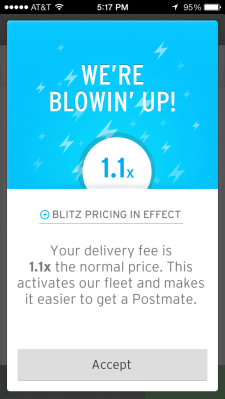Local delivery startup Postmates has been growing fast, which is a good problem to have. That is, unless demand is completely outstripping supply. With that in mind, the company is taking a big step toward regulating demand with the implementation of a new Uber-like Surge Pricing program called “Blitz.”
Postmates is now in three cities: San Francisco, Seattle, and New York. But in each case, the biggest problem that it currently faces is having enough couriers to actually make deliveries, according to CEO Bastian Lehmann. While it’s been aggressively on-boarding new Postmates, frequent customers might have noticed that sometimes it might not even be possible to get someone to make a delivery.
As a result, it’s decided to make a change that some other startups have made when faced with more demand than supply — it’s instituting Uber-like dynamic pricing that will scale up the cost of delivery when it sees higher demand. While Uber calls this “Surge Pricing,” Postmates calls its dynamic pricing “Blitz Pricing,”* but it kind of works in the same way.
The new Blitz pricing model is designed to help the platform to regulate demand for what is a finite resource — that is, the number of couriers that the company has available. Customers who try to order during those times will see a bigass notification (see above) letting them know Blitz pricing is underway, and will be able to accept the pricing. Or not.
In times of high demand, that means increasing the price by a certain percentage and allowing customers to decide if they really need whatever it is they’re ordering right away, or if they can wait until there are fewer orders in the system and more Postmates actually available.
Notifications during peak demand is just one way that Postmates is trying to be more transparent about its delivery pricing. While the company instituted dynamic pricing more than a year ago, changing from its previous flat-fee structure for all deliveries, it hadn’t done a great job of letting people know how much they would be charged.
Previously, its pricing model took into account a number of different factors: distance from restaurant, time of day, how quickly the restaurant processed the order, all kinds of junk. Now the pricing during non-peak hours is based solely on the distance from restaurant to dropoff.
Lazy and want someone to bring you food from the restaurant next door? That’ll be $5. Ordering from all the way across town? Deliveries cap out at $12 a piece. Either way, Postmates lets you know exactly what you’ll pay for that delivery.
That change is meant to create greater order density in specific neighborhoods, which keeps turnaround times faster and improves efficiency. Because being mo’ closer means mo’ orders delivered.
Blitz pricing should help regulate demand, as the company continues to onboard more Postmates. Lehmann says it recently streamlined that process, which should eventually help it to meet demand as the company grows. In the meantime, you might have to pay a few more cents when ordering your Jamba Juice every day, Shyp co-founder Jack Smith.
==
* Presumably because Postmates co-founder and CEO Bastian Lehmann is German.
